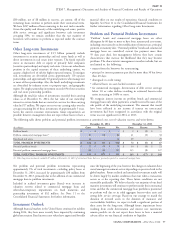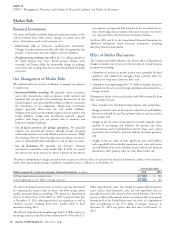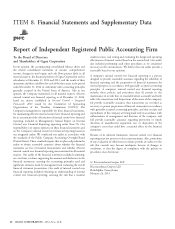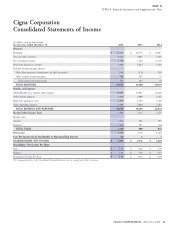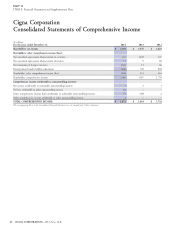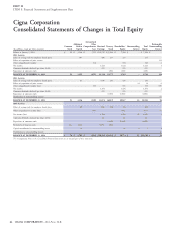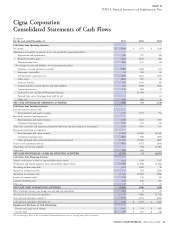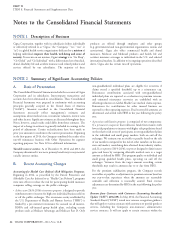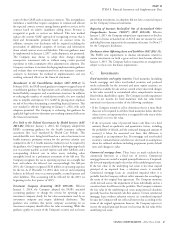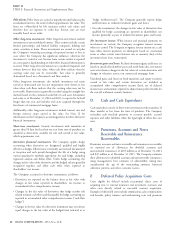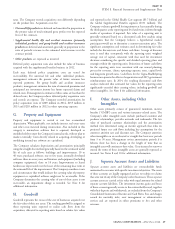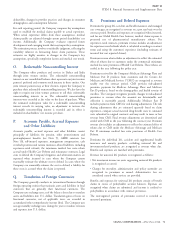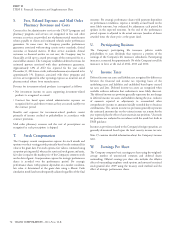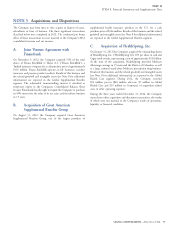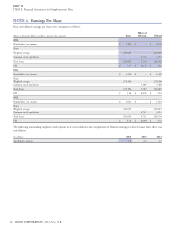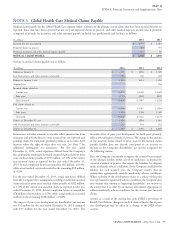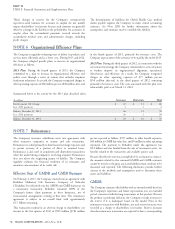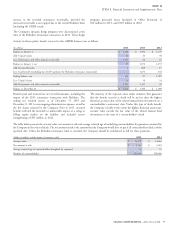Cigna 2014 Annual Report Download - page 99
Download and view the complete annual report
Please find page 99 of the 2014 Cigna annual report below. You can navigate through the pages in the report by either clicking on the pages listed below, or by using the keyword search tool below to find specific information within the annual report.PART II
ITEM 8. Financial Statements and Supplementary Data
scope of other GAAP, such as insurance contracts. This new guidance partnership investments, its adoption did not have a material impact
introduces a model that requires companies to estimate and allocate on the Company’s financial statements.
the expected contract revenue among distinct goods or services in the Reporting of Amounts Reclassified Out of Accumulated Other
contract based on relative standalone selling prices. Revenue is Comprehensive Income (‘‘AOCI’’) (ASU 2013-02). Effective
recognized as goods or services are delivered. This new method January 1, 2013, the Company adopted new requirements to disclose
replaces the current GAAP approach of recognizing revenue that is the effect of items reclassified out of AOCI into net income for each
fixed and determinable primarily based on contract terms. In individual line item impacted in the statement of income. See Note 17
addition, extensive new disclosures will be required including the for the Company’s disclosures.
presentation of additional categories of revenues and information
about related contract assets and liabilities. This new guidance must Disclosures about Offsetting Assets and Liabilities (ASU 2011-11).
be implemented on January 1, 2017; early adoption is not permitted. The FASB’s new requirements to disclose information related to
The Company may choose to adopt these changes through certain investments on both a gross and net basis became effective
retrospective restatement with or without using certain practical January 1, 2013. The Company had no transactions or arrangements
expedients or with a cumulative effect adjustment on adoption. The subject to these new disclosure requirements.
Company continues to monitor developing implementation guidance
and evaluate these new requirements for its non-insurance customer
C. Investments
contracts to determine the method of implementation and any
resulting estimated effects on the financial statements. Fixed maturities and equity securities. Fixed maturities (including
bonds, mortgage and other asset-backed securities and preferred
Amendments to the Consolidation Analysis (ASU 2015-2). In stocks redeemable by the investor) and most equity securities are
February 2015, the FASB issued guidance to improve targeted areas of classified as available for sale and are carried at fair value with changes
consolidation guidance for legal entities such as limited partnerships, in fair value recorded in accumulated other comprehensive income
limited liability companies and securitization structures. In addition (loss) within shareholders’ equity. The Company records impairment
to reducing the number of consolidation models, the new standard losses in net income for fixed maturities with fair value below
aims to simplify and improve U.S. GAAP by placing more emphasis amortized cost that meet either of the following conditions:
on risk of loss when determining a controlling financial interest. This
new standard is effective beginning on January 1, 2016, with early If the Company intends to sell or determines that it is more likely
adoption permitted. The Company is evaluating this guidance for than not to be required to sell these fixed maturities before their fair
applicable legal entities to determine any resulting estimated effects on values recover, an impairment loss is recognized for the excess of the
the financial statements. amortized cost over fair value.
Fees Paid to the Federal Government by Health Insurers (ASU If the net present value of projected future cash flows of a fixed
2011-06). Effective January 1, 2014, the Company adopted the maturity (based on qualitative and quantitative factors, including
FASB’s accounting guidance for the health insurance industry the probability of default, and the estimated timing and amount of
assessment (the ‘‘tax’’) mandated by Health Care Reform. This recovery) is below the amortized cost basis, that difference is
non-deductible tax is being levied based on a ratio of an insurer’s net recognized as an impairment loss. For mortgage and asset-backed
health insurance premiums written for the previous calendar year securities, estimated future cash flows are also based on assumptions
compared to the U.S. health insurance industry total. As required by about the collateral attributes including prepayment speeds, default
the guidance, the Company reports a liability at the beginning of each rates and changes in value.
year in accounts payable, accrued expenses and other liabilities and a Commercial mortgage loans. These loans are made exclusively to
corresponding deferred cost in other assets, including other commercial borrowers at a fixed rate of interest. Commercial
intangibles based on a preliminary assessment of the full year. The mortgage loans are carried at unpaid principal balances or, if impaired,
Company recognizes the tax in operating expenses on a straight line the lower of unpaid principal or fair value of the underlying real estate.
basis and reduces the deferred cost correspondingly. For full-year If the fair value of the underlying real estate is less than unpaid
2014, the Company recognized $238 million in operating expenses principal of an impaired loan, a valuation reserve is recorded.
for the tax. As of December 31, 2014, there were no such remaining Commercial mortgage loans are considered impaired when it is
balances in deferred costs or accounts payable, accrued expenses and probable that the Company will not collect amounts due according to
other liabilities. This accounting will be reflected for the 2015 tax the terms of the original loan agreement. The Company monitors
beginning in the first quarter of 2015. credit risk and assesses the impairment of loans individually and on a
Investment Company Accounting (ASU 2013-08). Effective consistent basis for all loans in the portfolio. The Company estimates
January 1, 2014, the Company adopted the FASB’s amended the fair value of the underlying real estate using internal valuations
accounting guidance to change the criteria for reporting as an generally based on discounted cash flow analyses. Certain commercial
investment company, clarify the fair value measurement used by an mortgage loans without valuation reserves are considered impaired
investment company and require additional disclosures. This because the Company will not collect all interest due according to the
guidance also confirms that parent company accounting for an terms of the original agreements; however, the Company expects to
investment company should reflect fair value accounting. While this recover the unpaid principal because it is less than the fair value of the
guidance applies to certain of the Company’s security and real estate underlying real estate.
CIGNA CORPORATION - 2014 Form 10-K 67
•
•


